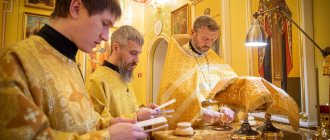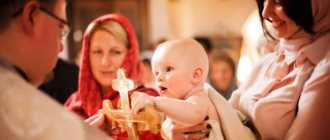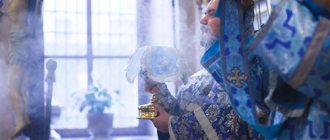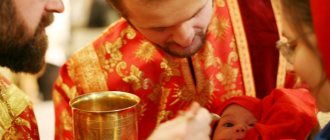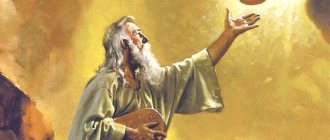The meaning of proskomedia
Translated from Greek, this term means “bringing” or “preparation,” which fully conveys the essence of the ritual. In the first centuries after the rise of Christianity, people baked prosphora themselves, which they brought to worship along with wine, and took back home at the end of the ceremony.
The sacrament of the Eucharist is a church ritual that helps to cleanse the soul and become closer to the Lord
Today, proskomedia is an action preceding the Divine Liturgy, consisting of the preparation of the Holy Gifts for the Sacrament of the Eucharist. During the ceremony, all the living and deceased are remembered, whose names were submitted to the priest with a special note.
Often parishioners confuse this ritual with mass, but the difference is simple. During the proskomedia, the priest takes out small pieces from the prosphora according to the number of people being commemorated. But during mass, he reads out notes to the choral singing of “What is Worthy.”
The ritual preceding the Divine Liturgy symbolizes the washing with the Blood of the Savior, and also represents the unity of the church. Pieces of bread drowning in wine represent the resurrection and subsequent eternal life. Metaphorically, this means the sacrifice of Christ, with which he atoned for all human sins. Thus, thanks to proskomedia, the soul is cleansed from passions, but only from those for which the layman has repented before the Lord.
The concept and history of the origin of proskomedia
The history of the emergence of the tradition of proskomedia dates back to the first centuries of the formation of Christianity. Believers religiously fulfilled the Old Testament injunctions “not to appear before the face of God empty-handed.” People came to the Liturgy with wine and bread. Part of the offerings was separated for church sacraments, the remaining gifts were used during common meals (agapes) for the glory of Christ. The gifts brought were prepared in a special way for the service.
The word "proskomedia" has Greek roots and means "bringing." Over time, communal meals were abandoned; by the 4th century, proskomedia began to be held in the middle of the liturgy, and in later times it became the initial part of the service. Today Proskomedia is a special rite, a symbol of eternal life, the meaning of which was explained by Christ. Orthodox Christians order sorokousts with small pieces of prosphora taken out for the health of their loved ones. They fulfill the covenant of Jesus, who immersed bread in wine and treated the apostles to a meal.
By communing with bread and wine, people are cleansed by the shed blood of the Savior and His body. The Old Believer tradition of performing proskomedia differs slightly - in the number of prosphoras and the design of the seals.
Time of the proskomedia
The rite is usually performed from 9 a.m. to 12 noon. But when the Divine Liturgy turns into Vespers, it is held in the afternoon, but only before dusk. According to the church charter, all days of the week are suitable for proskomedia, except:
- Wednesdays and Fridays of Cheese Week;
- Monday, Tuesday, and Thursday throughout Easter Lent;
- Good Friday (unless it falls on Annunciation);
- Fridays before Christmas and Epiphany.
Also, the ritual is prohibited from being performed on the days of the Liturgy of the Presanctified Gifts:
- Monday, Tuesday, Wednesday of Holy Week;
- Monday, Tuesday, Thursday from the second week of Easter Lent;
- Wednesday, Friday of the first six weeks of Lent;
- Tuesday, Thursday of the fifth week of Easter Lent.
The rite is usually performed from 9 a.m. to 12 noon.
What is proskomedia in Orthodoxy?
Today, many people believe in God, but everyone understands rituals differently. You can talk about how they should be observed correctly for a very long time. In fact, any person has the right to make their own decision about faith in God. The most important thing is to remain a real person in absolutely any life situation and not cause harm to anyone.
If you have just recently started attending church, it will be difficult for you to understand the meaning of all the rituals. Proskomedia is one such action. This ritual raises many questions. Next, let's look at how this ritual occurs and how it differs from simple prayer for loved ones.
Preparation for the proskomedia
To the ceremony preceding the Divine Liturgy, parishioners usually bring prosphora and other gifts with them. The clergy prepare bread for the Sacrament of the Eucharist, as well as wine. They put on a festive robe, in which they perform a ritual, asking the Lord for the people mentioned in the notes. To perform the ritual, the church requires special Eucharistic utensils related to two main Orthodox events: Christmas and the Crucifixion of the Savior. Such items are:
- a cup for consecrating wine;
- dish for separating prosphoras;
- an asterisk symbolizing the Star of Bethlehem;
- double-sided knife with a triangular blade;
- cloth panels that cover the paten and chalice separately;
- the material that joins the bowl and metal dish together;
- censer;
- anti-mine sponges;
- brass ladle;
- vessels for sacred bread, wine and water.
Wine and bread: requirements
The following criteria apply to bread:
- it must be leavened or white;
- when preparing bread, yeast must be used, because this is exactly the dish that Jesus offered his followers;
- the dough must be well kneaded;
- Only fresh baked goods are used for food;
- The shape of the prosphora is made round. They should also be two-tiered, thereby emphasizing the duality of the earthly and heavenly nature of the Savior;
- When preparing prosphora, seals with images of saints are used. The prosphora of the Lamb is used for communion. It must bear the letters NIKA (which means winner) and ICXC (which means Jesus Christ). These symbols are separated by a cross. In fact, this means the following: just as Jesus saved humanity by dying on the crucifixion, so wheat after its death allows a person to survive;
- The wine for proskomedia must be red grape. Jesus also drank this wine at the Last Supper. In churches, Cahors is used for this purpose to conduct services. It was the wine of this brand that was considered the best at all times;
- Wine for the ceremony is usually diluted with water. It serves as a reminder of the moment when Jesus was pierced with a spear on the cross.
The procedure for performing the ritual
The ritual is performed in the altar with the gates closed in Church Slavonic. The priest performs it in a low voice, since the ritual symbolizes the Birth of Christ, who came into our world very quietly. First, the priest reads a prayer over five prosphoras laid out on a platter. Next, he uses a knife to cut out a cube from the middle of the Big Bread, representing the Sacrificial Lamb, which he places on the paten. After this, he takes out smaller pieces from the remaining prosphoras:
- in the name of the Blessed Virgin Mary;
- John the Baptist;
- apostles;
- prophets;
- saints;
- all church members.
The priest places small pieces of prosphora around the Lamb in a certain order established by the church charter.
The next stage of proskomedia is reading notes about health and repose. With each name pronounced, the priest cuts out a piece from the smaller loaves, saying: “Remember, Lord (name).” After the end of the ritual, all the particles are placed in a chalice with wine, and the clergyman reads a prayer.
Completing the ritual, the priest brings out the star. With it he covers a piece of the Large Prosphora so that the cloth for covering the bowl and paten does not touch it. The shrouds symbolize the swaddling clothes that covered the newborn Jesus, as well as the shroud used after His martyrdom.
Next, the clergyman conducts censing on the walls of the temple and the parishioners present. It is no coincidence that incense is used, because it was the first gift of the Magi who came to visit the infant Christ.
Concluding the ritual, the priest prayerfully asks the Almighty to accept the prosphora dipped in wine as a sacred gift, and also to grant mercy to everyone mentioned in the notes. Then the entrance to the Altar is solemnly opened, metaphorically opening for all humanity the Gates of the Kingdom of Heaven, which bestows eternal life. Next, the service smoothly flows into the second part of the Divine Liturgy.
Cutting out prosphoras
Reading notes on health and repose
Each wall of the temple
What is the difference between proskomedia and mass?
The main difference between proskomedia and mass is the ritual and time of remembrance. During the service, the priest reads a prayer and takes out several pieces from the prosphora. And during the ceremony of mass, the church minister reads the notes, and the church choir at this time sings “It is Worthy to Eat.” Both rites are carried out publicly or secretly.
The most ideal is considered to be commemoration during the entire service intended for this. The special power of remembering one’s neighbor does not differ from each other.
We have discussed what proskomedia is in Orthodoxy. But before it takes place, the deacon and priest prepare very carefully, which makes it possible to carry out the ceremony in accordance with all Orthodox rules. There are several most important and simply necessary nuances that must be observed:
- Before going to the altar, a prayer must be read. It is repeated immediately before the altar;
- To perform a sacred ceremony, the clergyman must wear clothes specially designed specifically for this rite;
- The church minister performs the hand washing procedure, during which he reads verses from the 25th Psalm.
The best article for you, go to: How to be baptized correctly for Orthodox Christians
The service itself takes a short amount of time. The deacon and the priest stand directly opposite the altar, on which are placed sacred vessels filled with an asterisk, a shroud, a chalice, a spear and a paten. Rituals using sacred bread are carried out while reading prayer verses.
After reading the prayer, the church ministers prepare for the liturgy, which is the solemn part of the service. It must also follow certain rules:
- glorification of the holy meal by all parishioners and the deacon;
- reading several prayers specifically intended for this rite;
- the deacon's request from the clergyman to proceed to the next part of the liturgy.
It is difficult to unequivocally answer the question of which is better: a proskomedia for health or a prayer service. Each church ceremony is individual and useful in its own way. In order to decide what kind of prayer you need in the current situation, it is recommended to seek help from the clergy.
The Lord is always with you!
How to submit a health note to Proskomedia
Before the start of the ritual, parishioners, as a rule, submit special notes to the clergyman, which mention the names of those for whom they are asked to pray. Common prayer, strengthened by a single faith, helps to cope with illness, difficult financial situations, or end a streak of failures in life. However, for it to have an effect, the person being prayed for must also make some efforts:
- be baptized according to Orthodoxy;
- have sincere faith in God's help;
- lead a righteous lifestyle, regularly cleansing your body and soul with prayers.
Notes are usually written on small forms that are sold in the temple. However, the church charter allows the use of half a regular notebook sheet. The purpose of the commemoration must be indicated at the top: for health or for repose.
You can write no more than ten names on one form. They are entered in block letters or in clearly legible words in the genitive case. First, you can indicate the status of the person commemorated (prisoner, sick, wandering, baby).
Notes are usually written on small forms
It is important to submit a note in advance so that the priest understands how many pieces of prosphora will be on the paten.
Author's advice
Today, every church belonging to the Moscow Patriarchate is open to submitting applications for proskomedia. Absolutely any names can be entered on the form, except for those people who have not accepted the Orthodox faith or have not undergone the rite of Baptism.
Proskomedia is an integral part of the Sacrament of the Eucharist. The service is structured in such a way that the sacred rites smoothly flow into each other, and each of them has its own meaning. By performing a ritual over the Sacred Gifts, there is an appeal to the Lord so that He will forgive sins and allow His children to reunite with Him.
If you find an error, please select a piece of text and press Ctrl+Enter.
№2 (100) / 13 •April• '11
Archpriest Andrey Kanev Current Conversation
In one of the issues of the “Orthodox Messenger” (see PV No. 5 (94) 2010), an article by Archpriest Alexy Yakovlev about commemoration at the Divine Liturgy was published. The priest quite clearly shared the “necessary wisdom” with his readers.
But, nevertheless, questions continue to be asked: is commemoration at the Liturgy really that serious? What is its meaning? Is this useful for everyone? Is it possible to harm the soul with this commemoration? Who to remember, who not to remember – and so on and so forth. In order to find answers to these perplexities, let's turn to the patristic heritage.
Question: why are particles taken out for people at Proskomedia? What is the benefit of these particles for humans?
Saint Simeon, Metropolitan of Thessalonica:
“The teaching has come down to us from the ancient Fathers that particles bring many different benefits to those for whom they are offered. During sacred rites, the particles represent the very people on whose behalf they are taken out, and are sacrificed to God for them. This is confirmed by the words of the priest pronounced during the proskomedia: “Receive, O Lord,” he says, this sacrifice on Your heavenly altar!” “The particles brought to the Saints serve them for glory, honor, for increasing their dignity and for greater acceptance of the Divine Light; for the faithful, those offered to the deceased intercede for deliverance from sins and the participation of Divine grace, while for the living, if they live their lives only in repentance, they give protection from misfortunes, serve as an intercession for the remission of sins” (Simeon of Thessalonica. About the temple. // I. Dmitrevsky. Historical, dogmatic and sacramental explanation of the Divine Liturgy. St. Petersburg - M., 2009. - pp. 349-350).
Question: If commemoration at the Liturgy brings so many benefits: remission of sins, protection from sorrows, then we need to register all our relatives and friends for commemoration, since we wish them well.
They all need the Lord's help, even if they don't understand it. Is it correct?
Venerable Leo of Optina:
“We must not openly remember sinners who are in unrepentance, in error and schism; according to the interpretation of church teachers - through the combination of particles taken out for their names with the Divine Blood - not purification, but condemnation occurs for them... Submit to the proskomedia about your neighbors known to you; and pray for others in general, and in your thoughts try to consider everyone as saints (however, without imitating their bad deeds) ... " (Soulful teachings of the Optina elders. Letter 207 to Thomas Nikitich and others, January 31, 1836 - Holy Vvedenskaya Optina Hermitage, 2000).
Question: It turns out that a person who does not believe in Christ should not be remembered at the Liturgy. But what about us - simple Christians who go to church, confess, but nevertheless sin. Can we be remembered in this sacred rite?
Saint Simeon, Metropolitan of Thessalonica:
“If the soul is pious, or although through weakness it falls into sin, it is then cleansed by repentance: such a soul invisibly receives the communion of the Holy Spirit, and is often rewarded with bodily benefits, this is evidenced by repeated experience” (Simeon of Thessaloniki. About the temple. // I. Dmitrevsky Historical, dogmatic and sacramental explanation of the Divine Liturgy. St. Petersburg - M., 2009. - P. 351).
Venerable John of Damascus:
“for those who receive (Communion) with faith, it worthily serves for the remission of sins and eternal life
and in keeping soul and body; and for those who receive communion with unbelief, it is unworthy - as punishment and punishment" (John of Damascus. An accurate exposition of the Orthodox faith. Chapter 13. About the holy and most pure sacraments of the Lord. - Moscow, 1992).
Question: By the grace of God, a repentant Christian receives benefit from commemoration, but does a person who is baptized, but lives without a concept of faith, repentance, sin, passions, receive it? Will an offering at the proskomedia benefit him?
Saint Simeon, Metropolitan of Thessalonica:
“If someone, being given over to sin, and does not want to retreat from it, such as someone unworthy of communion with God, will receive the worst condemnation from the sacrifice made for him <...>
As much as it is beneficial for the one for whom this sacrifice is made when he lives worthy of the Christian calling, so much is it disastrous and harmful for the one who, having given himself over to a sinful life, neglects to properly correct the Christian calling. For a particle, being brought on behalf of any Christian, and lying near the Divine Bread, when it is sacredly celebrated and transformed into the Body of the Lord, becomes part of the sanctification, and brought into the dissolution of the Holy Chalice is then watered with the life-giving Blood: why and the soul for which it was brought sometimes he sends down grace; then the spiritual union of man with God takes place” (Simeon of Thessaloniki. About the temple. // I. Dmitrevsky. Historical, dogmatic and mysterious explanation of the Divine Liturgy. St. Petersburg - M., 2009. - P. 350).
Question: Is grace an undoubted benefit to the soul?
St. Righteous Nicholas Kavasilas:
“Grace sanctifies us through the Gifts if it finds us capable of sanctification; if it meets us unprepared, it will not bring any benefit and will cause countless harm.” (Nicholas Kavasila, Archbishop of Thessaloniki, explanation of the Divine Liturgy,” chapter 34. - St. Petersburg, 1857).
Question: Is there a criterion by which we can conclude that a person has fallen away from the Church and cannot be remembered at the proskomedia?
Venerable Simeon the New Theologian:
“A clear sign that a person is naked from the grace of holy Baptism is his own recognition that he cannot in any way stop and cut off his shameful lust and cannot refrain from satisfying it with shameful deeds.
And how many such unfortunates do we have, who are all the more unhappy because they do not recognize and do not feel their plight?! Meanwhile, we see that some of them reach such madness that they dare to partake of the most pure Body and priceless Blood of Christ. What shamelessness and self-forgetfulness!
Woe to the one who receives communion, because, receiving communion after shameful deeds not purified by repentance and penances, he falls more and more under the power of the devil, and finally is completely taken over by him; and God completely forsakes such a one for his shamelessness and uncleanness, and especially for his shamelessness and insolence, as the Holy Gospel writes about Judas, that as soon as he partook of the bread given to him by Christ the Lord, this divine supper, immediately Satan went into him through the bread
(John 13:27). (St. Simeon the New Theologian. Words. The thirty-third word to those who partake of the Divine Mysteries. - And who partakes unworthily. - M., 2006. - P. 400).
80 rule 6 of the Ecumenical Council:
“If anyone, a bishop, or a presbyter, or a deacon, or anyone of those numbered among the clergy, or a layman, having no urgent need or obstacle that would remove him from his church for a long time, but staying in the city, on three Sundays days over the course of three weeks, does not come to the church meeting: then the cleric will be expelled from the clergy, and the layman will be excommunicated.”
Question: Will commemoration at the proskomedia be useful for a person who has died and has not had time to repent?
Rev. Paisiy Velichkovsky:
“Remembrance for the dead is the most important part of the bloodless sacrifice made for Orthodox Christians, both living and dead. If someone, even an Orthodox Christian, clearly sins and does not repent, then the Holy Church forbids him to make a bloodless sacrifice until he completely abandons his sin and sincerely repents.
If the Church does not allow a bloodless sacrifice to be made for an Orthodox open sinner, unrepentant, then can it allow one to be made for someone who has died without any repentance in opposition to the Holy Church? No way. Saint Simeon, Archbishop of Thessaloniki, testifies to an obvious sinner that it is not appropriate for him to partake of the Holy Mysteries and it is impossible to make a bloodless sacrifice for him with the following words: “There is no place for the infidel or the wise.” Therefore, no priest should make a sacrifice or make a commemoration of someone who is clearly sinning and unrepentant, since this offering is for their condemnation, just as the reception of the Terrible Mysteries is unworthy and without repentance for those who partake, as the divine Paul says about this (See .: 1 Cor. 11, 29). <…> Church commemoration should not be performed for those who died without repentance and in opposition to the Holy Church. He who dares to commemorate such people will pay a terrible answer for this before Christ God on the day of His Last Judgment” (Sergius Chetverikov. Elder Paisiy Velichkovsky. - Minsk, 2006. - pp. 276-277).
Question: What is the measure of responsibility of a clergyman in the matter of liturgical commemoration of people?
Saint Simeon, Metropolitan of Thessalonica:
“The priest must carefully observe so as not to accept offerings and offer sacrifices for such people who, having banished shame and conscience from their hearts, indulge in all lawlessness; for this the priest himself is condemned along with them.
Because of this, many different temptations and sorrows befall a person” (Simeon of Thessalonica. About the temple. // I. Dmitrevsky. Historical, dogmatic and mysterious explanation of the Divine Liturgy. St. Petersburg - M., 2009. - P. 351).
Dear brothers and sisters! Commemoration at the proskomedia turns out to be not a simple parish service, but a higher and more responsible matter associated with the Sacrament of Communion, capable of cleansing a repentant Christian from sin and punishing an unrepentant sinner. Christians must respect the freedom of another person and know their faith, so that in a good impulse they do not harm themselves or others. And if a person did not ask for himself to be prayed for as a faithful
, then we shouldn't do it.
To help such people there are prayer services - like a joint church appeal to the Lord.
Thus, even unchurched Christians do not fall out of the sphere of attention of the Church, which prays for them in due time.
It is indeed dangerous to mindlessly meddle with any Sacraments and rituals.
And Baptism, and Wedding, and the consecration of apartments have real spiritual consequences.
Perplexities regarding proskomedia reveal a whole layer of serious problems: they are connected not only with the practical question of “who to remember and who not,” but with our attitude to the patristic teaching about salvation. We constantly want to solve spiritual problems quickly and easily. But if we accept the truth, then we will take our lives more deeply and seriously, which is what I would like to wish for the readers of the Orthodox Messenger.
•In other rooms:•
What is mass and when is it ordered?
Mass is a divine service held in a church, which is officially called liturgy .
The word “liturgy” is of Greek origin and means “common cause,” and the word “mass” appeared among the people because it was held before lunch. It is considered the most important service of the daily church circle; during mass the Eucharist, that is, Holy Communion, is celebrated.
The liturgy is conducted not according to order, but according to a schedule.
Even in conversation, notes with names that parishioners write, wanting to order a commemoration of the soul of the deceased or a mention of a neighbor in prayer for health, can also be referred to in conversation. This does not mean that, upon request, a separate service will be held dedicated only to the people indicated on the sheet, because there are quite a lot of such requests. It is understood that registered Christians during mass will be mentioned in prayer .
Is mass a church service or a type of prayer?
Every Orthodox Christian knows that the main central service of worship is the Liturgy. However, when submitting a note about health or repose in church, you can hear questions: “Are you submitting for Proskomedia? Maybe order Mass? No, it’s better for you to pray,” etc. Even a churchgoer can easily become confused. Mass - what is it? Is this a prayer or part of a worship service? Is it different from the Liturgy? We will answer these questions in this article.
Designation
It is worth saying that the most important church service is mass, or liturgy, where the sacrament of communion is celebrated. For this ritual, red grape wine is required, as well as bread or prosphora. They must be prepared in a special way before the start of the liturgy. To do this, the priest, together with the deacon, dressed in elegant sacred clothes, perform special actions on the altar, altar and read special prayers. We can conclude: before the liturgy, certain preparations are necessary, which by their nature are very important. That’s exactly what they are called proskomedia. It is worth saying that there is a proskomedia about repose, as well as about health.
Mass for the dead: what is it?
Mass for the dead is not some kind of separate service, different from the main one. During the Liturgy, there are moments when words of prayer are said for deceased baptized people.
Commemoration of the dead occurs at the following moments:
- During proskomedia, when extracting grain particles. This is the usual commemoration with a simple note of repose;
- After the presentation of the Holy Gifts. This is not a reading of specific names, but a general commemoration of everyone;
- During the funeral litany. In the Liturgy of the Catechumens there is a part devoted to the reading of a passage from the Gospel, then a litany begins, during which names are pronounced. To do this, you need to order a mass with a prayer service;
- After the service, during the memorial service for the repose. For such additional mention, an appropriate note must also be submitted at the memorial service.
It is believed that there is no need to write the name of an unbaptized person on the list to be read by a clergyman, but you can light a candle and pray for this person yourself.
About bread
So, proskomedia (we have already figured out what it is) is the most important stage of preparation for the liturgy. It is worth saying that the bread itself for this purpose is necessarily made from wheat flour (this is what the Jews consumed during the life of Christ). Its meaning was very important: it represented the atoning death of Jesus Christ. According to beliefs, everything can be known by comparison: after all, only by dying and becoming bread can wheat bring many benefits. However, if it simply crumbles on the field, it will not fulfill its most important purpose. The same applies to the sacrifice of Jesus Christ. The very preparation of prosphora is considered a sacred act: the bread should be white, not anointed with anything at the preparation stage (milk, eggs), and moderately salted. It is served only fresh, not moldy, not hard. It is also interesting that the bread consists of two halves, which symbolize the human and divine likeness of Christ.
Types of notes
It is worth saying that there are two types of notes. First, a proskomedia about health can be ordered. Before starting the service, you need to write down on a special piece of paper, which will most often be located near the candle counter, the names of people for whose health you need to pray. According to the same document, a proskomedia for the repose is performed. When writing down people's names, it is important to carefully read the inscriptions on top and not mix up the leaves. If you need to order a commemoration at the proskomedia, you can submit a note in the evening, simply indicating the required date.
What do they do with other prosphora?
All other prosphoras also have their own purpose. They are used when proskomedia (mass) is held. From the second, the Mother of God, a triangular part is taken out. This is a symbol of remembrance of the Mother of God. From the third, nine-fold, nine parts are taken out. They symbolize the saints and are placed on the left side of the Lamb. Only two parts are removed from the fourth. The first is intended for living clergy, and the second is for the health of Orthodox laity. They are laid out below the Lamb. Lastly, a part taken from the fifth bread, which is a symbol of remembrance of the dead, is placed on the paten.


